Organisational Structure
Organisational structure is defined as the
relatively enduring allocation of work roles and administrative mechanisms that creates a pattern of interrelated work activities and allows the organisation to conduct, co-ordinate and control its work activities
To put it in simple words Organisational structure refers to the levels of management and division of responsibilities within an organisation.
In an organization of any size or complexity, employees' responsibilities typically are defined by what they do, who they report to, and for managers, who reports to them. Over time these definitions are assigned to positions in the organization rather than to specific individuals. The relationships among these positions are illustrated graphically in an organizational chart.
Watch a Video
Types of Organisation Structure
Line Organisation
It is perhaps the oldest and the simples organisational structure. In this kind of structure every manager exercise a direct authority over his subordinate who in turn directly reports to their superiors.
- There is a hierarchical arrangement of authority.
- Each department is self contained and works independently of other departments.
- Lines of authority are vertical i.e. from top to bottom.
- There are no staff specialists.
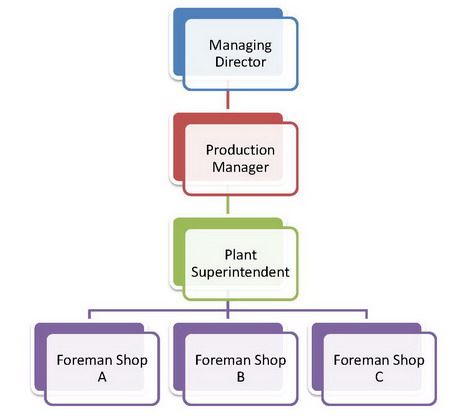
download Line organisational structure![]()
Advantages
- Simple to establish and operate
- Promotes prompt decision making.
- Easy to control as the managers have direct control over their subordinates.
- Communication is fast and easy as there is only vertical flow of communication.
Disadvantages
- Lack of specialisation
- Managers might get overloaded with too many things to do.
- Failure of one manager to take proper decisions might affect the whole organisation.
However, line structures are suitable for
- small businesses where there are few subordinates
- organisations where there is largely of routine nature and methods of operations are simple.
Functional Organisation
The organisation is divided into a number of functional areas. This organisation has grouping of activities in accordance with the functions of an organisation such as production, marketing, finance, human resource and so on.
The specialist in charge of a functional department has the authority over all other employees for his function.
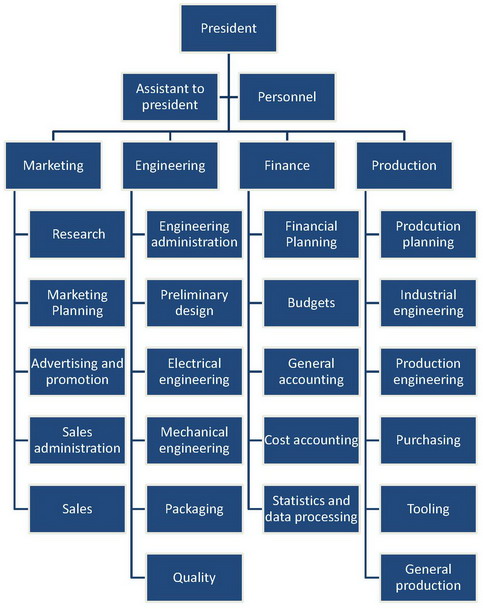
download Functional organisational structure![]()
Advantages
- Is logical and reflection of functions
- Follows principle of occupation specialisation
- Simplifies training
- Better control as the manger in charge of each functional department is usually an specialist.
Disadvantages
- Overspecialisation and narrow viewpoints of key personnel can limit the organisation growth.
- Reduced coordination between functions.
- Conflicts between different functions could be detrimental for the organisation as a whole.
- Difficult for general managers to coordinate different departments.
However, it is much suitable for large organisations where there is ample scope for specialisation. Once harmony and proper coordination among different functions is achieved, it could lead to sure success for an organisation.
Watch a Video
Line and Staff Organisation
It is a combination of line and functional structures. In this organisation a structure, the authority flows in a vertical line and get the help of staff specialist who are in advisory. When the line executives need advice, information about any specific area, these staff specialists are consulted.
For example Chief accountant has command authority over accountants and clerks in the accounts departments but he has only advisory relationship with other departments like production or sales.
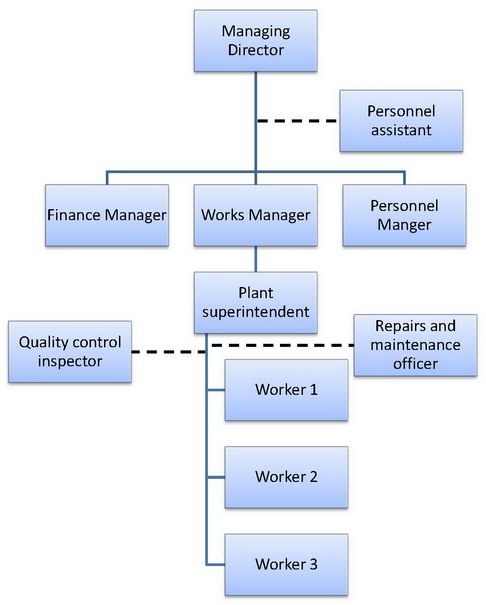
download Line and Staff organisational structure![]()
Advantages
Line managers are provided by expert advice by these specialists.
Staff managers provide specialist advice which can improve quality of decisions in various departments.
Disadvantages
Line managers and staff managers might have conflicts on particular issues.
Line and staff managers might not be clear as to what the actual area of operations is and what is expected of them. Co-ordination may be a problem.
Staff personnel are not accountable for the results and thus may not take tasks seriously.
However, Line and staff organisation is very suitable for large organisation.
Project Organisation
The project structure consists of a number of horizontal organisational units to complete projects of a long duration. A team of specialists from different areas is created for each project. Usually this team is managed by the project manager. The project staff is separate from and independent of the functional departments.
Advantages
- Special attention can be provided to meet the complex demand of the project.
- It allows maximum use of specialist knowledge thus chances of failure are very less.
- Project staff works as a team towards common goal which results in high motivation level for its members.
Disadvantages
As the project staff consists of personnel from diverse fields, it might be quite challenging for the project manager to coordinate among them.
Matrix Organisation
- Matrix organisation combines two structures – functional departmentation and project structure.
- Functional department is a permanent feature of the matrix structure and retains authority for overall operation of the functional units.
- Project teams are created whenever specific projects require a high degree of technical skill and other resources for a temporary period.
- Project team form the horizontal chain and functional departments create a vertical chain of command.
- Members of a particular team are drawn from the functional departments and are placed under the direction of a project manager who has the overall responsibility of a particular project.
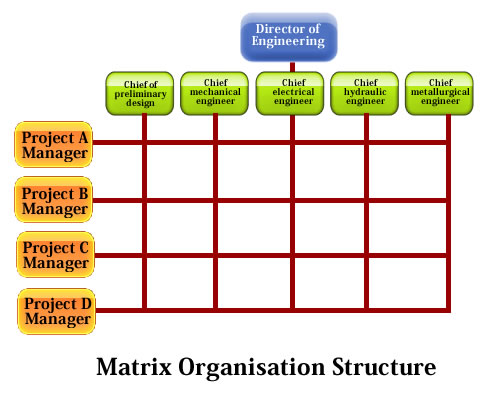
download Matrix organisational structure![]()
Advantage
- Is oriented towards end results.
- Professional identification is maintained
- Pinpoints product-profit responsibility
Disadvantages
- Conflict in organisation authority exists.
- Possibility of disunity of command exists
- Requires manager effective in human relations
Matrix organisations is used in industries with highly complex product systems for example, aerospace industry where project teams are created for specific space or weapon systems.
Watch a Video
Organisational Structure
Organisational structure is defined as the “relatively enduring allocation of work roles and administrative mechanisms that creates a pattern of interrelated work activities and allows the organisation to conduct, co-ordinate and control its work activities”.
To put it in simple words Organisational structure refers to the levels of management and division of responsibilities within an organisation.
In an organization of any size or complexity, employees' responsibilities typically are defined by what they do, who they report to, and for managers, who reports to them. Over time these definitions are assigned to positions in the organization rather than to specific individuals. The relationships among these positions are illustrated graphically in an organizational chart.
Types of Organisation Structure
Line Organisation
It is perhaps the oldest and the simples organisational structure. In this kind of structure every manager exercise a direct authority over his subordinate who in turn directly reports to their superiors.
There is a hierarchical arrangement of authority.
Each department is self contained and works independently of other departments.
Lines of authority are vertical i.e. from top to bottom.
There are no staff specialists.

download Line organisational structure![]()
Advantages
- Simple to establish and operate
- Promotes prompt decision making.
- Easy to control as the managers have direct control over their subordinates.
- Communication is fast and easy as there is only vertical flow of communication.
Disadvantages
- Lack of specialisation
- Managers might get overloaded with too many things to do.
- Failure of one manager to take proper decisions might affect the whole organisation.
However, line structures are suitable for
- small businesses where there are few subordinates
- organisations where there is largely of routine nature and methods of operations are simple.
Functional Organisation
The organisation is divided into a number of functional areas. This organisation has grouping of activities in accordance with the functions of an organisation such as production, marketing, finance, human resource and so on.
The specialist in charge of a functional department has the authority over all other employees for his function.
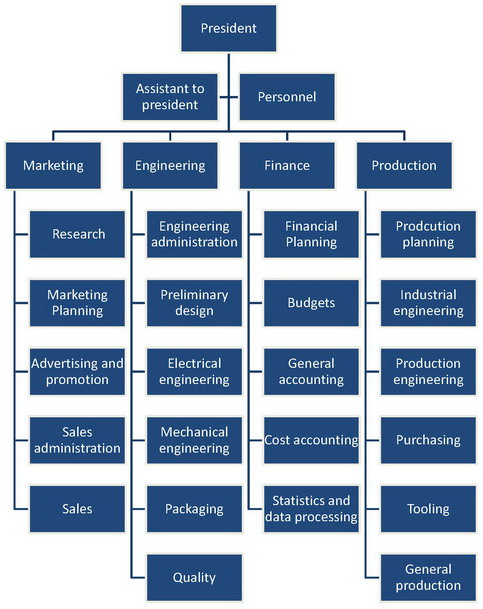
download Functional organisational structure![]()
Advantages
- Is logical and reflection of functions
- Follows principle of occupation specialisation
- Simplifies training
- Better control as the manger in charge of each functional department is usually an specialist.
Disadvantages
- Overspecialisation and narrow viewpoints of key personnel can limit the organisation growth.
- Reduced coordination between functions.
- Conflicts between different functions could be detrimental for the organisation as a whole.
- Difficult for general managers to coordinate different departments.
However, it is much suitable for large organisations where there is ample scope for specialisation. Once harmony and proper coordination among different functions is achieved, it could lead to sure success for an organisation.
Line and Staff Organisation
It is a combination of line and functional structures. In this organisation a structure, the authority flows in a vertical line and get the help of staff specialist who are in advisory. When the line executives need advice, information about any specific area, these staff specialists are consulted.
For example Chief accountant has command authority over accountants and clerks in the accounts departments but he has only advisory relationship with other departments like production or sales.
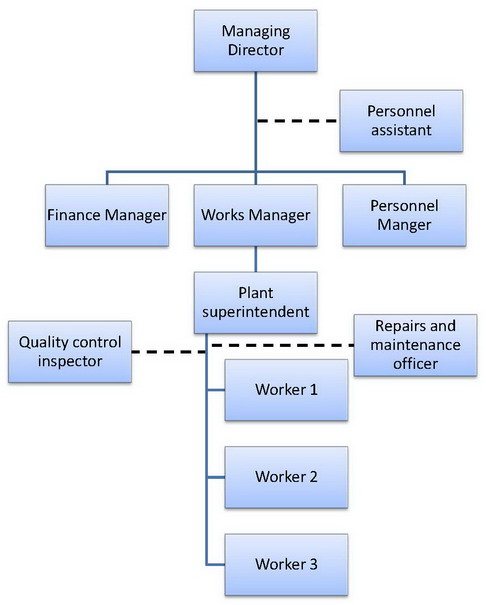
download Line and Staff organisational structure![]()
Advantages
Line managers are provided by expert advice by these specialists.
Staff managers provide specialist advice which can improve quality of decisions in various departments.
Disadvantages
Line managers and staff managers might have conflicts on particular issues.
Line and staff managers might not be clear as to what the actual area of operations is and what is expected of them. Co-ordination may be a problem.
Staff personnel are not accountable for the results and thus may not take tasks seriously.
However, Line and staff organisation is very suitable for large organisation.
Project Organisation
The project structure consists of a number of horizontal organisational units to complete projects of a long duration. A team of specialists from different areas is created for each project. Usually this team is managed by the project manager. The project staff is separate from and independent of the functional departments.
Advantages
- Special attention can be provided to meet the complex demand of the project.
- It allows maximum use of specialist knowledge thus chances of failure are very less.
- Project staff works as a team towards common goal which results in high motivation level for its members.
Disadvantages
As the project staff consists of personnel from diverse fields, it might be quite challenging for the project manager to coordinate among them.
Matrix Organisation
Matrix organisation combines two structures – functional departmentation and project structure.
Functional department is a permanent feature of the matrix structure and retains authority for overall operation of the functional units. Project teams are created whenever specific projects require a high degree of technical skill and other resources for a temporary period.
Project team form the horizontal chain and functional departments create a vertical chain of command.
Members of a particular team are drawn from the functional departments and are placed under the direction of a project manager who has the overall responsibility of a particular project.

download Matrix organisational structure![]()
Advantage
- Is oriented towards end results.
- Professional identification is maintained
- Pinpoints product-profit responsibility
Disadvantages
- Conflict in organisation authority exists.
- Possibility of disunity of command exists
- Requires manager effective in human relations
Matrix organisations is used in industries with highly complex product systems for example, aerospace industry where project teams are created for specific space or weapon systems.





